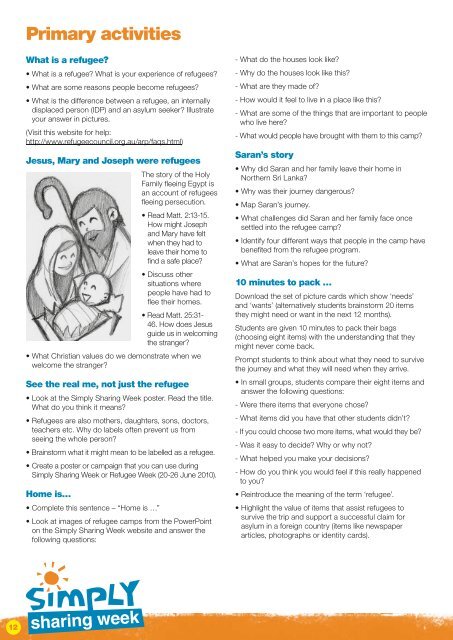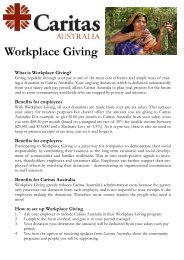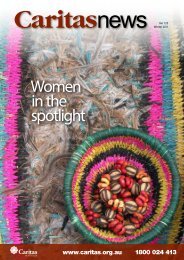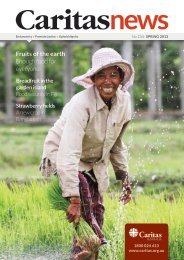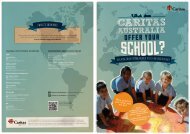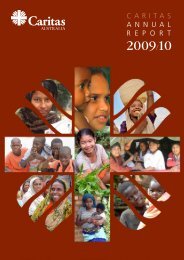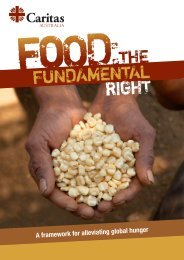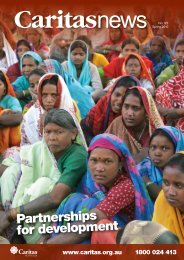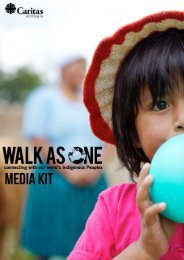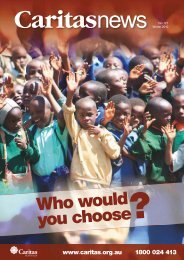Primary activities - Caritas Australia
Primary activities - Caritas Australia
Primary activities - Caritas Australia
You also want an ePaper? Increase the reach of your titles
YUMPU automatically turns print PDFs into web optimized ePapers that Google loves.
<strong>Primary</strong> <strong>activities</strong>What is a refugee?• What is a refugee? What is your experience of refugees?• What are some reasons people become refugees?• What is the difference between a refugee, an internallydisplaced person (IDP) and an asylum seeker? Illustrateyour answer in pictures.(Visit this website for help:http://www.refugeecouncil.org.au/arp/faqs.html)Jesus, Mary and Joseph were refugeesThe story of the HolyFamily fl eeing Egypt isan account of refugeesfl eeing persecution.• Read Matt. 2:13-15.How might Josephand Mary have feltwhen they had toleave their home tofi nd a safe place?• Discuss othersituations wherepeople have had tofl ee their homes.• Read Matt. 25:31-46. How does Jesusguide us in welcomingthe stranger?• What Christian values do we demonstrate when wewelcome the stranger?See the real me, not just the refugee• Look at the Simply Sharing Week poster. Read the title.What do you think it means?• Refugees are also mothers, daughters, sons, doctors,teachers etc. Why do labels often prevent us fromseeing the whole person?• Brainstorm what it might mean to be labelled as a refugee.• Create a poster or campaign that you can use duringSimply Sharing Week or Refugee Week (20-26 June 2010).Home is…• Complete this sentence – “Home is …”• Look at images of refugee camps from the PowerPointon the Simply Sharing Week website and answer thefollowing questions:- What do the houses look like?- Why do the houses look like this?- What are they made of?- How would it feel to live in a place like this?- What are some of the things that are important to peoplewho live here?- What would people have brought with them to this camp?Saran’s story• Why did Saran and her family leave their home inNorthern Sri Lanka?• Why was their journey dangerous?• Map Saran’s journey.• What challenges did Saran and her family face oncesettled into the refugee camp?• Identify four different ways that people in the camp havebenefi ted from the refugee program.• What are Saran’s hopes for the future?10 minutes to pack …Download the set of picture cards which show ‘needs’and ‘wants’ (alternatively students brainstorm 20 itemsthey might need or want in the next 12 months).Students are given 10 minutes to pack their bags(choosing eight items) with the understanding that theymight never come back.Prompt students to think about what they need to survivethe journey and what they will need when they arrive.• In small groups, students compare their eight items andanswer the following questions:- Were there items that everyone chose?- What items did you have that other students didn’t?- If you could choose two more items, what would they be?- Was it easy to decide? Why or why not?- What helped you make your decisions?- How do you think you would feel if this really happenedto you?• Reintroduce the meaning of the term ‘refugee’.• Highlight the value of items that assist refugees tosurvive the trip and support a successful claim forasylum in a foreign country (items like newspaperarticles, photographs or identity cards).12
Before, during, after and the futureWrite the following words on the board to ensure that students develop comprehensive answers: food, water, health,education, religion, cultural <strong>activities</strong>, work.Students choose either Sri Lanka or Sudan as their focus area.Students will need four sheets of paper to do the following exercise:A) Write ‘Before’ in the middle of your page and create a mind map of what life might have been like for a child your age living inSri Lanka or Sudan before there was confl ict.B) Write ‘During’ in the middle of your page and create a mind map of what life would be like on the journey to another countrybecause it was too dangerous to stay at home.C) Write ‘After’ in the middle of your page and create a mind map of what life would be like for a child your age afterseeking refuge and participating in the projects within the refugee camp.D) Write ‘The Future’ in the middle of your page and create a mind map of what it is you hope for the future.A refugee campHave groups of students:- Imagine they are in charge of a refugee camp with about 1,000 people.- Fill in the table below using the given information (minimum requirements to determine the resources and personnelneeded to provide for the refugees).NeedsMinimum requirements in arefugee campWhat is needed to meet theneeds of 1000 refugeesWhat you have access to in<strong>Australia</strong>Water15 litres per person per day(one tap per 250 people)Food2100 calories per personper dayToilet1 toilet for 20 peopleShelterOne sheet of plastic per familyHealthAt least one healthcare workerper 5000 peopleEducationOften there is no school(Source: http://www.sphereproject.org/). (This activity was taken from the activity titled ‘Life in a refugee camp’ found at www.globaleducation.edna.edu.au)UNHCR – Lego posters and teachers guideThis a great series of <strong>activities</strong> based on posters that explore the issue of refugees.For the teacher guide go to: http://www.unhcr.org/help/HELP/46a755202.htmlDownload the posters from http://unhcr.org.au/pdfs/140603LegoA2Posters.pdfwww.simplysharingweek.org.au13


